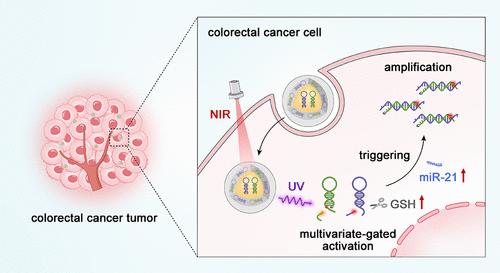Spatially Selective MicroRNA Imaging in Human Colorectal Cancer Tissues Using a Multivariate-Gated Signal Amplification Nanosensor
IF 14.4
1区 化学
Q1 CHEMISTRY, MULTIDISCIPLINARY
引用次数: 0
Abstract
MicroRNA (miRNA) is involved in the genesis in viand development of colorectal cancer. The in vivo imaging of miRNA at the tumor sites is essential for understanding its role in colorectal cancer pathology and therapeutic target identification. However, achieving accurate imaging of miRNA at the tumor sites is hindered by the low abundance of miRNAs in tumor cells and nonspecific signal leakage in normal tissues. Here, we report a multivariate-gated catalytic hairpin assembly (CHA) nanosensor for the specific amplified imaging of microRNA-21 (miR-21) in human colorectal cancer tissues to reveal the underlying miR-21-associated molecular mechanism. The endogenous glutathione and exogenous near-infrared multivariate-gated design in combination with CHA probes improves the signal strength of target miR-21 and reduces the background interference. The nanosensor enables specific amplified imaging of miR-21 in vivo, and the signal-to-background ratios are 1.6-fold compared with traditional CHA methods. With the assistance of the designed nanosensor, we achieve the preliminary identification of tumor tissues and normal tissues from human clinical surgical resection samples. The overexpressed miR-21 is found to suppress the core mismatch repair recognition protein human mutS homologue 2 involved in DNA damage recognition and repair to inhibit the therapeutic efficacy of colorectal cancer. The strategy of probe design, which combines multivariate-gated activation methods with a signal amplification system, is applicable for accurate miRNA imaging and disease-relevant molecular mechanism research.

利用多变量门控信号放大纳米传感器对人类结直肠癌组织中的微RNA进行空间选择性成像
本文章由计算机程序翻译,如有差异,请以英文原文为准。
求助全文
约1分钟内获得全文
求助全文
来源期刊
CiteScore
24.40
自引率
6.00%
发文量
2398
审稿时长
1.6 months
期刊介绍:
The flagship journal of the American Chemical Society, known as the Journal of the American Chemical Society (JACS), has been a prestigious publication since its establishment in 1879. It holds a preeminent position in the field of chemistry and related interdisciplinary sciences. JACS is committed to disseminating cutting-edge research papers, covering a wide range of topics, and encompasses approximately 19,000 pages of Articles, Communications, and Perspectives annually. With a weekly publication frequency, JACS plays a vital role in advancing the field of chemistry by providing essential research.

 求助内容:
求助内容: 应助结果提醒方式:
应助结果提醒方式:


